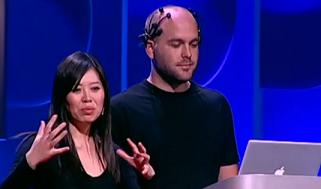
Tan Le isn’t just interested in reading your mind, she wants to have fun while doing it. Le is one of the founders of Emotiv, maker of the EPOC headset – a streamlined EEG device that translates your thoughts and facial expressions into computer inputs. It’s been hyped as bringing a new dimension to video games. At this year’s TED conference, Le gave a wonderful presentation on EPOC, letting a first time user demonstrate how it could control a simulated object. Available as low as $300, EPOC is one of the least expensive brain computer interfaces you can find on the market. Watch the Emotiv headset in action during Le’s TED Talk in the video below. She reveals parts of the UI and capabilities of the device that you haven’t seen anywhere else.
Calling the EPOC a brain computer interface is a little bit generous. With only 14 channels, it’s a fairly simple version of EEG. Certainly we’ve seen more complex BCIs that are currently on the market. Yet EPOC is an order of magnitude cheaper than these more advanced devices, and seems to be able to translate a wide variety of brain activity into computer commands. In the TED demonstration we are able to see a first time user pull a virtual object (~4:55) and even make that object disappear (~6:45) using monitored brain activity. In both these cases EPOC only had a single point of reference from which to base the commands. Clearly the learning algorithm of the system is fairly capable. Eventually, commercial BCIs like EPOC may enjoy a wide range of applications. Le highlights a few in the video below, including video games (8:20), automated machines (8:50), and wheelchairs (9:30).
As we discussed in our original review of Emotiv, the EPOC headset may not make it as a video game controller. Sure, being able to lift an object with the power of your mind sounds cool, but the reality looks difficult and unwieldy. I’m not sure I would spend $300 on it. Sharing my facial expressions through online avatars is only somewhat appealing, and having a virtual landscape that adjusts to my emotions seems like a recipe for disaster. Also, at the $300 level you can only use the headset with approved software applications, which are very limited at this point. Bottom line, I’m much more impressed that the EPOC system can perform all these video game tasks than I am with the game applications themselves.
Maybe Emotiv agrees? They’ve made their SDK for the EPOC very affordable – starting at just $500. Research packages are a little more expensive ($750) and advanced enterprise and education adopters will likely pay $2500-$7500 for development. These are all relatively cheap prices, and may encourage third party developers to find that killer app that the EPOC needs.
I have really no idea what that app will be. Other commercial EEG devices are either typing tools for helping patients with locked-in syndrome communicate (high-end), or novelty products for hobbyists (low-end). EPOC is clearly not the latter, but I don’t know if it has the spatial/temporal resolution for the former. I doubt it, otherwise I think Le would have shown us that at some point. Still, with a reasonable purchase price, and a robust system of capabilities, chances are that EPOC could find a good use fairly soon. It’s a great example of how BCIs are getting cheaper and more powerful as companies explore the technology. One day brain-computer interactions will become so sophisticated that traditional human-computer interfaces, like the keyboard, will become obsolete. We’re not there yet, but Le’s presentation gives me hope that we’re on the right path. In preparation for the coming BCI revolution I’m doing a bunch of mental exercises. Picturing my computer disappear is strangely relaxing.
[screen capture and video credit: TED Talks]
[source: Emotiv]



